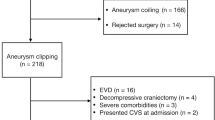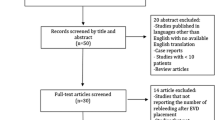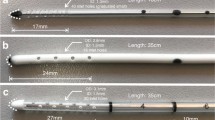Summary
Background. Does continuous external lumbar CSF drainage before aneurysm repair in patients with aneurysmal subarachnoid hemorrhage increase the risk of rebleeding?
Method. The study population, consisting of 18 patients treated by External Lumbar Drainage (ELD) after SAH before aneurysm repair, was compared with an independent control group of 324 SAH patients treated in another clinic. Control patients were selected for not being treated for the ruptured aneurysm yet and not having undergone any form of CSF drainage during the exposure time in the case patients. We calculated hazard ratios with the Cox regression model, adjusted for age and clinical condition on admission and hydrocephalus.
Findings. The cox regression analysis shows a non-adjusted hazard ratio of 2.1 (95% CI 0.8 to 5.3) in the model with 5 rebleedings in 18 patients. Adjustment for age, clinical condition on admission and hydrocephalus did not alter the hazard ratio estimate importantly in either analyses.
Conclusions. An increased risk of rebleeding by external lumbar drainage in the acute phase after aneurysmal SAH could not be confirmed, but the data are too imprecise to rule out an increased risk. The potential benefits of early drainage should be weighed against the risks if the aneurysm is not occluded before or early after the start of drainage.
Similar content being viewed by others
References
EH Brilstra GJ Rinkel A Algra J van Gijn (2000) ArticleTitleRebleeding, secondary ischemia, and timing of operation in patients with subarachnoid hemorrhage. Neurology 55 1656–1660 Occurrence Handle11113219
CG Drake (1988) ArticleTitleReport of World Federation of Neurological Surgeons Committee on a universal subarachnoid hemorrhage grading scale. J Neurosurg 68 985–986 Occurrence Handle3131498
Y Fujii S Takeuchi O Sasaki T Minakawa T Koike R Tanaka (1996) ArticleTitleUltra-early rebleeding in spontaneous subarachnoid hemorrhage. J Neurosurg 84 35–42 Occurrence Handle8613833
Jv Gijn A Hijdra E Wijdicks M Vermeulen Hv Crevel (1985) ArticleTitleAcute hydrocephalus after aneurysmal subarachnoid hemorrhage. J Neurosurg 63 355–362 Occurrence Handle4020461
Y Handa BK Weir M Nosko R Mosewich T Tsuji M Grace (1987) ArticleTitleThe effect of timing of clot removal on chronic vasospasm in a primate model. J Neurosurg 67 558–564 Occurrence Handle3655894
D Hasan M Vermeulen E Wijdicks A Hijdra Jv Gijn (1989) ArticleTitleManagement problems in acute hydrocephalus after subarachnoid hemorrhage. Stroke 20 747–753 Occurrence Handle2728040
T Inagawa (1994) ArticleTitleUltra-early rebleeding within six hours after aneurysmal rupture. Surg Neurol 42 130–134 Occurrence Handle10.1016/0090-3019(94)90373-5 Occurrence Handle8091289
T Inagawa K Kamiya Y Matsuda (1991) ArticleTitleEffect of continuous cisternal drainage on cerebral vasospasm. Acta Neurochir (Wien) 112 28–36 Occurrence Handle10.1007/BF01402451
T Inagawa K Kamiya H Ogasawara T Yano (1987) ArticleTitleRebleeding of ruptured intracranial aneurysms in the acute stage. Surg Neurol 28 93–99 Occurrence Handle10.1016/0090-3019(87)90079-6 Occurrence Handle3603360
H Kasuya T Shimuzu M Kagawa (1991) ArticleTitleThe effect of continuous drainage of cerebrospinal fluid in patients with subarachnoid hemorrhage: a retrospective analysis of 108 patients. Neurosurg 28 56–59 Occurrence Handle10.1097/00006123-199101000-00009
K Kawai H Nagashima A Tamura K Sano (1997) ArticleTitleEfficacy and risk of ventricular drainage in cases of grade V subarachnoid hemorrhage. Neurol Res 19 649–653 Occurrence Handle9427968
P Klimo SuffixJr JR Kestle JD MacDonald RH Schmidt (2004) ArticleTitleMarked reduction of cerebral vasospasm with lumbar drainage of cerebrospinal fluid after subarachnoid hemorrhage. J Neurosurg 100 215–224 Occurrence Handle15086227
N Kodama T Sasaki M Kawakami M Sato J Asari (2000) ArticleTitleCisternal irrigation therapy with urokinase and ascorbic acid for prevention of vasospasm after aneurysmal subarachnoid hemorrhage. Outcome in 217 patients. Surg Neurol 53 110–117 Occurrence Handle10.1016/S0090-3019(99)00183-4 Occurrence Handle10713187
J Kusske P Turner G Ojemann B Harris (1973) ArticleTitleVentriculostomy for the treatment of acute hydrocephalus following subarachnoid hemorrhage. Neurosurg 38 591–595
J McIver J Friedman E Wijdicks D Piepgras M Pichelmann L Toussaint R McClelland D Nichols J Atkinson (2002) ArticleTitlePreoperative ventriculostomy and rebleeding after aneurysmal subarachnoid hemorrhage. J Neurosurg 97 1042–1044 Occurrence Handle12452133
T Milhorat (1987) ArticleTitleAcute hydrocephalus after aneurysmal subarachnoid hemorrhage. Neurosurg 20 15–20
T Nakagomi K Takagi K Narita H Nagashima A Tamura (2001) ArticleTitleCisternal washing therapy for the prevention of cerebral vasospasm following aneurysmal subarachnoid hemorrhage. Acta Neurochir (Wien) [Suppl] 77 161–165
H Nornes (1973) ArticleTitleThe role of intracranial pressure in the arrest of hemorrhage in patients with ruptured intracranial aneurysm. J Neurosurg 39 226–234 Occurrence Handle4719700
M Nosko BK Weir A Lunt M Grace P Allen B Mielke (1987) ArticleTitleEffect of clot removal at 24 hours on chronic vasospasm after SAH in the primate model. J Neurosurg 66 416–422 Occurrence Handle3819837
H Ochiai Y Yamakawa (2001) ArticleTitleContinuous lumbar drainage for the preoperative management of patients with aneurysmal subarachnoid hemorrhage. Neurol Med Chir (Tokyo) 41 576–581 Occurrence Handle10.2176/nmc.41.576
H Ohkuma H Tsurutani S Suzuki (2001) ArticleTitleIncidence and significance of early aneurysmal rebleeding before neurosurgical or neurological management. Stroke 32 1176–1180 Occurrence Handle11340229
L Pare R Delfino R Leblanc (1992) ArticleTitleThe relationship of ventricular drainage to aneurysmal rebleeding. J Neurosurg 76 422–427 Occurrence Handle1738021
AJ Raimondi H Torres (1973) ArticleTitleAcute hydrocephalus as a complication of subarachnoid hemorrhage. Surg Neurol 1 23–26 Occurrence Handle4784573
V Rajshekar R Har baugh (1992) ArticleTitleResults of routine ventriculostomy with external ventricular drainage for acute hydrocephalus following subarachnoid haemorrhage. Acta Neurochir (Wien) 115 8–14 Occurrence Handle10.1007/BF01400584
S Sakaki S Ohta H Kuwabara M Shiraishi (1987) ArticleTitleThe role of venticular and cisternal drainage in the early operation for ruptured intracranial aneurysms. Acta Neurochir (Wien) 88 87–94 Occurrence Handle10.1007/BF01404143
B Voldby E Enevoldsen (1982) ArticleTitleIntracranial pressure changes following aneurysm rupture. J Neurosurg 56 784–789 Occurrence Handle7077377
Author information
Authors and Affiliations
Rights and permissions
About this article
Cite this article
Ruijs, A., Dirven, C., Algra, A. et al. The risk of rebleeding after external lumbar drainage in patients with untreated ruptured cerebral aneurysms. Acta Neurochir (Wien) 147, 1157–1162 (2005). https://doi.org/10.1007/s00701-005-0584-5
Received:
Accepted:
Published:
Issue Date:
DOI: https://doi.org/10.1007/s00701-005-0584-5




